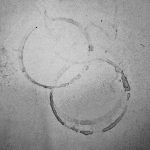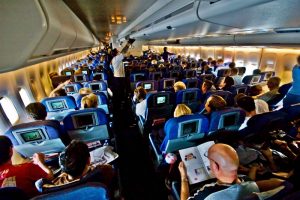As June turns into July airports and airplanes are growing increasingly crowded. The two major air travel holidays are approaching, and everyone wants to get through it as healthy as when they left home. Gildshire Magazines wanted to find out if there are any foolproof ways to stay healthy on a flying vacation. As it turned out, there aren’t, but we did find ways of tipping the odds in your favor. You may not find these tips in Hemispheres and Rhapsody or Alaska Beyond while you’re in the air, but they are important bits of helpful information.
“This Is Your Captain Speaking. Put Your Seat in the Full Upright Position and Avoid Touching That Petri Dish of Bacteria We Call Your Tray.” Airline employees who have left the industry tell horror stories about what happens on that tray table.

Some of these stains are probably coffee. The others…
Dirty hands fondle it, diapers desecrate it, the bottoms that will, eventually, wear the diapers sit on it. Those are just the more speakable things that happen to it. Do they get wiped down between flights? Are they sanitized? Maybe, or maybe not, and almost never. Bring along a disinfectant wipe if you are going to touch that nasty surface.
“While You’re At it, Just Don’t Touch Hardly Anything.” We know you want fresh air, and we want it for you. The recirculated cabin air has every pathogen your fellow travelers have contracted for the last 30 days. Just know that the vent handle rivals your tray table for grossness per square centimeter. We aren’t big believers in disinfectant squirts at home because they kill the good with the bad. We make an exception when we board for air travel. Tray tables, air vents, call buttons, bathroom doorknobs, and seat handles/armrests. They all get a swabbing from our disinfecting wipe.
“Sit Back…Relax…and Take a Deep Breath.” The Captain will say the first two things, but he/she may not add the third one. That’s a shame because what and how you breathe on a plane is different from at home. Your plane will fly, on average, at an altitude of 35,000 feet. The cabin is pressurized because you would quickly expire at that altitude if you were outside. Did you know, though, that the plane isn’t pressurized to the kinds of altitude at which most of us live? That’s right, your cabin is pressurized to 8,000 feet. Normal if you reside near the peak of a major mountain, but foreign to flatlanders. Combat this by taking long, slow, deep breaths.
“This is Your Captain Saying ‘Shake Your Groove Thing.” I would never shop for the best deal on airfare again if, just once, my pilot talked like this. We know exercise is important on the ground.

The guy in Seat 13B is on the wrong flight. He thinks he’s going to Baton Rouge. Walk up there and help him out.
Did you know it’s even more important in the air? Deep vein thrombosis is a real thing and three or more hours in a cramped seat and under lowered oxygen can bring it on. If your flight is just a couple of hours, say San Francisco to Denver, relax in your seat if you want. If you board a plane in Seattle for a nonstop to Boston, get up! Walk the aisle and check out the pretty faces who are going where you are going. They may want to get together with you for a drink in Boston.
“Wake Up!” Actually, it would weird me out if the pilot suddenly said this one. Most air travel veterans have a routine. They know about the invasive TSA business. They know what they can carry-on and to look for their connecting flight on the monitor at the gate to which they arrive. Even veteran flyers, though, miss one trick and it will impact them for up to a week. Time zones are energy-sappers. The savvy flyer attunes to a new time zone up to a week in advance, and even longer for a super-lengthy trip. Here is what you should be doing. If air travel takes you across 3-5 time zones, adjust your sleep patterns the previous week. That means west-to-east travelers go to bed earlier and get up earlier. East-to-west flyers do the opposite.
“Captain Stubing Here, Saying, ‘Stay Hydrated and Avoid Drinking Water.” It may sound like your Captain is overtired and losing his mind, but what he says is true. Staying hydrated before, during and after your flight is key, but not with airline tap water. Studies have shown airplane water to have up to 115% of the microbes found in municipal tap water. So, drink plenty of water in the days before your flight, and plenty of water in the days following. In the air, ask for bottled water. If the flight attendant runs out of bottled water, say “I’ll pass, thank you anyway.”
Air travel doesn’t have the glamor factor it once had, but it is still the fastest way to get from Little Billy’s house in Hamtramck to Grampa Will’s home in Hanford. No one wants to see Billy (or Will, for that matter) catch a summer disease because of airplane germs. Follow these ideas and everyone has a better shot at health and happiness on summer break.




